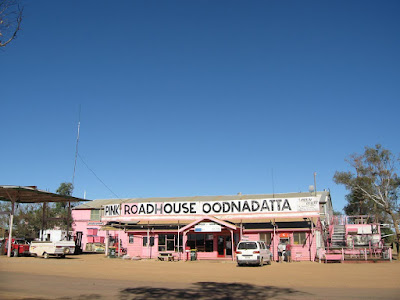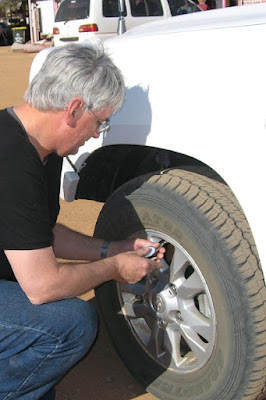 From Wirraminna we drove to Coober Pedy – the Opal capital of the world - staying at the Stuart Ranges Camping Park.
From Wirraminna we drove to Coober Pedy – the Opal capital of the world - staying at the Stuart Ranges Camping Park. Mining on a large scale started after World War I – and the ex-Diggers faced with lack of timber and used to living in trench occupied the failed mines. The local aborigines thought these men were the ghosts of their ancestors who had lost their colour, and called them Kupta Piti loosely translated as white men jumping out of holes. This became Coober Pedy.
Next day we took the Stuart Tour. This was a fabulous tour with a wealth of information.

We saw the Breakaways and gazed out on what was once the bottom of the ocean bed many millions of years ago. We saw moon rocks and the moon plain. We also saw rocks made of fossilized salt water. Moon rocks are very popular for decorating the above ground buildings.
We stopped at the dog fence which is designed to keep the dingoes north.
We visited the Serbian Church, an underground church that is world heritage listed [only twelve years after it was built], and the only one we know of with a bar.
When you look at this hill every vent has a room underneath it. Air goes out through the small vents. The larger vents pull air in very slowly and it is either warmed or cooled by the rocks depending on the season.
Correctly done the temperature will remain between 23C [73F] and 25C [77F] degrees all year round. This is why underground living is so popular here as the ambient temperatures on the surface vary from -2C [28F] to 65C[149F].
 We saw an old time dugout, very dusty, and a modern dugout which is finished with silcrete to eliminate the dust. A new dugout it is left for a year or more so the rock dries out. Otherwise there are constant problems with damp. Houses can be as grand as you want; all you have to do is dig another room and as miners these guys are pretty good at that. One has an indoor lap pool and shooting range for his high powered rifle. And noise from parties stays indoors.
We saw an old time dugout, very dusty, and a modern dugout which is finished with silcrete to eliminate the dust. A new dugout it is left for a year or more so the rock dries out. Otherwise there are constant problems with damp. Houses can be as grand as you want; all you have to do is dig another room and as miners these guys are pretty good at that. One has an indoor lap pool and shooting range for his high powered rifle. And noise from parties stays indoors.

The vacuum cleaner truck [a local invention] sucks excavated rock from the mine. When the drum fills the vacuum is blocked, the drum base opens and empties the drum thus restarting the vacuum and sucking the drum base closed again. All the mine dumps are about 10% opal and a popular pastime is noodling for opal, that is sifting through the piles of rubble and seeing what you can find. Noodling can be dangerous because of all the mine holes and because the dumps are inherently unstable.
When a seam of opal is found, it still has to be mined by hand.
Opal is formed from a solution of silicon dioxide and water. As water runs down through the earth, it picks up silica from sandstone, and carries this silica-rich solution into cracks and voids , caused by natural faults or decomposing fossils. As the water evaporates, it leaves behind a silica deposit. This cycle repeats over very long periods of time, and eventually opal is formed.
Golf, mostly played at night with glowing balls, is on a course which replicates Royal St Andrews minus the grass. This is the only golf course which has reciprocal rights with St. Andrew Golf course

Before leaving we filled our tanks, water is scarce here. It comes from a bore into the Great Artesian Basin and reverse osmosis is used to make it drinkable. This means they have great water but they charge for it.
Main street Coober Pedy. The Desert Cave Hotel has some dugout rooms and excellent coffee


 We had time to drive back into the Painted Desert and enjoy the sunset sitting on a rock. This was very special.
We had time to drive back into the Painted Desert and enjoy the sunset sitting on a rock. This was very special. 



















































![NEW - THE MAPS [By Popular Request]](https://blogger.googleusercontent.com/img/b/R29vZ2xl/AVvXsEjHG1GHJCw30W7yaMbn9QB-NguxDm0UBxGPEy7qV7lsrcEFPKm_7fcurfCO47uI3fax5yInPaNuygFhPiaX-CHlS1KO26YGmjK7qIz5SLChr-2LGgdriqpA-L1PDtyBBjD0WBPltishqpo/s187/Around+Australia.jpg)